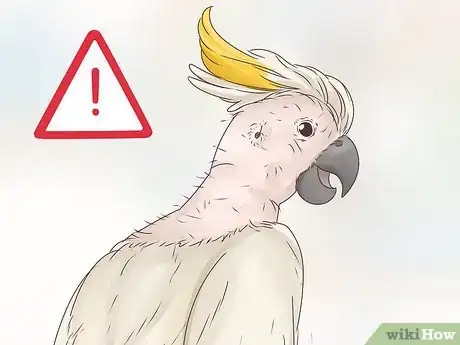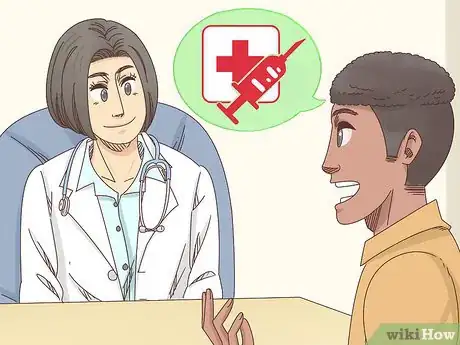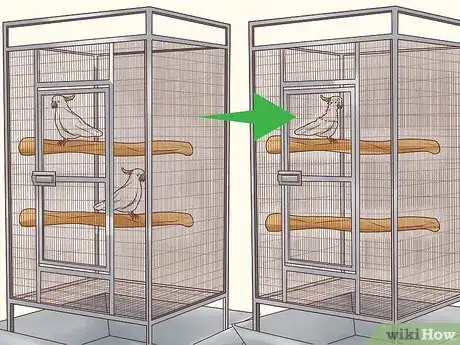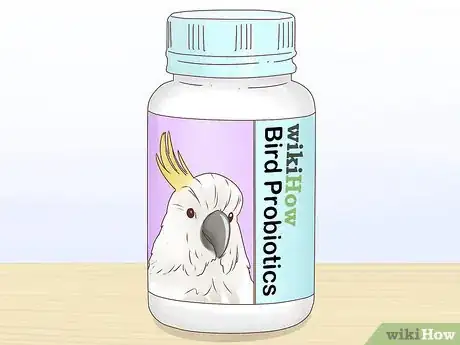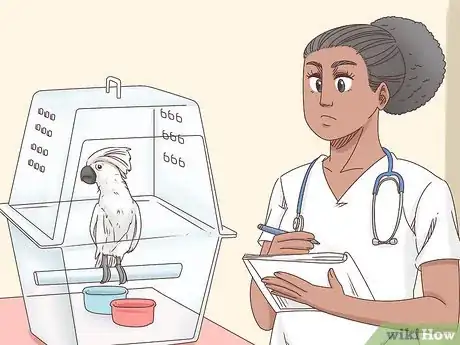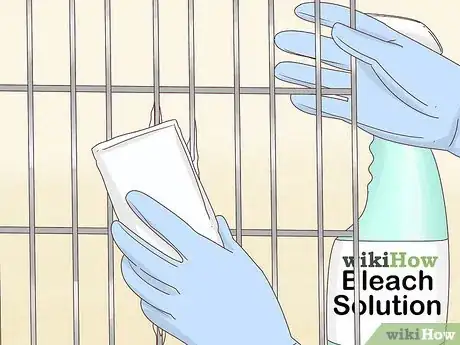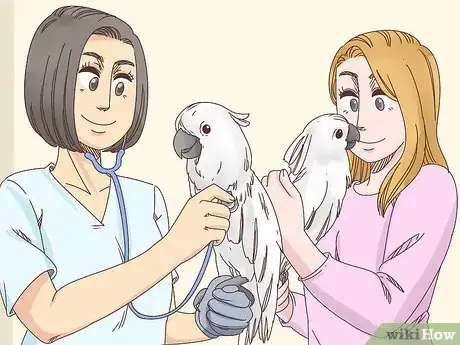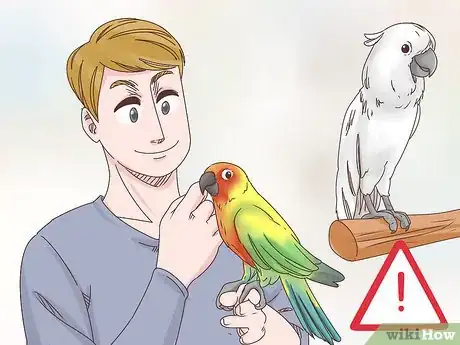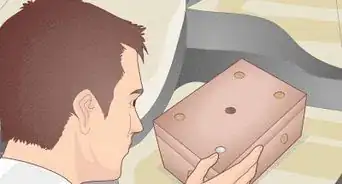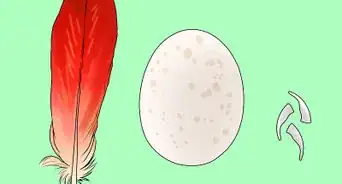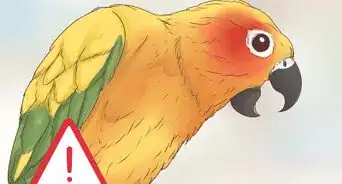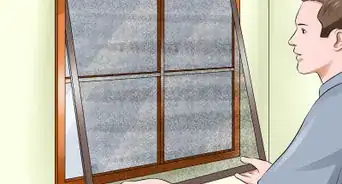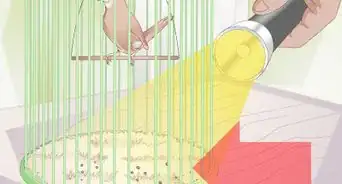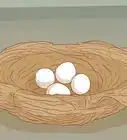This article was co-authored by Pippa Elliott, MRCVS. Dr. Elliott, BVMS, MRCVS is a veterinarian with over 30 years of experience in veterinary surgery and companion animal practice. She graduated from the University of Glasgow in 1987 with a degree in veterinary medicine and surgery. She has worked at the same animal clinic in her hometown for over 20 years.
This article has been viewed 41,481 times.
Psittacine beak and feather disease (PBFD) is a common virus among parrots, including cockatoos. This disease can cause feather shedding, lesions, and sores on the bird. It is usually fatal, though some birds can have a prolonged life with the virus with the proper home care.[1] To treat PBFD, start by bringing the cockatoo to the vet for a diagnosis. You can then try doing home care to maintain the bird’s quality of life. PBFD can be prevented in cockatoos with the right approach.
Steps
Bringing the Cockatoo to the Vet
-
1Watch for the symptoms of the disease. Cockatoos with PBFD will lose their down feathers and will be constantly be moulting, or shedding. They will also develop dystrophic feathers, which appear very thin, stunted, or misshapen.[2]
- Cockatoos with PBFD will also develop lesions on their beak, which will appear as dry sores that are irritated or red.
-
2Take your cockatoo to the vet right away. If you notice any symptoms of PBFD in your cockatoo, contact your vet and bring in the bird for a diagnosis as soon as possible. Catching PBFD early can give you a chance to nurse the bird and maintain its quality of life.
- Call your vet before you go in so they know you are bringing in a cockatoo with PBFD. The virus is highly contagious and your bird should be kept away from other pets at the vet.
Advertisement -
3Allow the vet to do tests on the cockatoo. The vet will do a physical exam of the cockatoo. They will also take a sample of the cockatoo’s skin, blood, and feathers for testing. The tests should show if the bird has PBFD.
- Keep in mind some cockatoos will display no clinical signs of the virus and still test positive for PBFD.
- Your vet may test the cockatoo twice, once on your first visit, and then 60-90 days later. If both samples are positive, the cockatoo has chronic PBFD and will be considered permanently infected.
-
4Discuss treatment options. If the vet confirms the cockatoo has PBFD, they will outline possible treatment options for your bird. There is currently no treatment for the virus and it is often considered fatal. However, your vet can give the bird antiviral drugs that may help the cockatoo's symptoms improve.[3]
- You can also do home care and maintain the bird’s quality of life so it does not suffer. In some cases, birds with PBFD that receive good home care do recover from the virus.
- Note that PBFD weakens your cockatoo’s immune system, making them more vulnerable to serious secondary infections. Seek prompt treatment if you suspect a secondary condition has developed.
- If your cockatoo is diagnosed with chronic PBFD, its chances of survival long-term are slim. The vet may recommend euthanizing the cockatoo to stop its suffering and prevent it from having to deal with the degenerative symptoms of the virus.
Doing Home Care
-
1Quarantine the infected bird. PBFD is highly contagious and birds with the virus should be separated from other birds and pets in your household. Keep the bird in a separate cage in a separate area or room. Make sure the bird does not interact with other pets.[4]
- You will need to quarantine the bird until it has fully recovered from PBFD. Only once it has been tested by your vet and confirmed free of the virus should you let it interact with other pets.
-
2Provide a diet rich in nutrients and vitamins. Make sure you feed the cockatoo bird pellets that are high quality. Pellets should make up 80 to 90 percent of their diet. You can give the bird fruits like apples, pears, and bananas. Cockatoos also like vegetables like squash, sweet potatoes, broccoli, and kale.[5]
- Always wash and slice fruits and vegetables before giving them to the cockatoo. Remove the skin on the fruits and vegetables as well.
- Include grains like rice, quinoa, and beans in their diet. About 10 to 20 percent of their diet should be grains, fruits, and vegetables. Mix up their meals so the bird gets a variety of foods that are fresh.
- Do not give birds avocados, as they can be fatal.
-
3Give the cockatoo probiotics. Talk to your vet about probiotics that are safe for your cockatoo. Probiotics help to support your bird’s immune system and prevent secondary infections that can make its condition worse.[6]
- Most probiotics are given orally with the cockatoo’s food. Ask your vet about the appropriate dosage for your cockatoo. Do not give the cockatoo more than the recommended amount.
-
4Treat the cockatoo for secondary infections. Birds with PBFD are susceptible to infections in their lungs, eyes, and skin. If you notice the bird is having breathing problems, sight issues, or skin issues, get it treated right away. Bring it to the vet for a diagnosis and treat all secondary infections so they do not get worse.[7]
- Treating secondary infections will ensure the cockatoo maintains a decent quality of life while it tries to recover from PBFD. Untreated secondary infections can put the bird's life in danger.
-
5Sterilize the cockatoo’s cage regularly. Clean the cockatoo’s cage once a day and once a week. Sterilize it with a vinegar solution or a bleach solution. If you use bleach to clean the cockatoo’s cage, make sure you rinse the cage well so there is no remaining bleach in the cage.[8]
- You should also clean the cockatoo’s food and water dishes.
- Do not use the same cleaning supplies for the cockatoo’s cage and other pet cages in your home. This can spread the virus.
Preventing Psittacine Disease
-
1Purchase cockatoos from a reputable breeder. A good breeder will test their birds for any viruses or infections before they are sold. They can also provide the medical history of the bird and confirm the bird is healthy.[9]
-
2Get all cockatoos tested for the disease. Your vet can perform the test quickly and efficiently. Always test every cockatoo or bird that you buy before you bring it into your home. This will ensure your other pets are not at risk of PBFD.[10]
-
3Be careful when handling other birds. Do not handle birds that appear to have feather shedding or lesions. Avoid touching birds if you do not know its medical history. Do not let your cockatoos interact with other birds unless you know their medical history and are sure they do not have PBFD.[11]
- Always wash your hands well before and after handling your cockatoo, as well as other birds.
Expert Q&A
-
QuestionWhat causes beak and feather disease?
 Pippa Elliott, MRCVSDr. Elliott, BVMS, MRCVS is a veterinarian with over 30 years of experience in veterinary surgery and companion animal practice. She graduated from the University of Glasgow in 1987 with a degree in veterinary medicine and surgery. She has worked at the same animal clinic in her hometown for over 20 years.
Pippa Elliott, MRCVSDr. Elliott, BVMS, MRCVS is a veterinarian with over 30 years of experience in veterinary surgery and companion animal practice. She graduated from the University of Glasgow in 1987 with a degree in veterinary medicine and surgery. She has worked at the same animal clinic in her hometown for over 20 years.
Veterinarian PBFD is caused by a virus from the Circovirus family. This groups of viruses are highly species-specific (which means they tend not to cross-infect other species). Most of the members are adapted to cause infections in birds, but some types can also cause a specific illness in pigs.
PBFD is caused by a virus from the Circovirus family. This groups of viruses are highly species-specific (which means they tend not to cross-infect other species). Most of the members are adapted to cause infections in birds, but some types can also cause a specific illness in pigs. -
QuestionCan beak and feather disease affect humans?
 Pippa Elliott, MRCVSDr. Elliott, BVMS, MRCVS is a veterinarian with over 30 years of experience in veterinary surgery and companion animal practice. She graduated from the University of Glasgow in 1987 with a degree in veterinary medicine and surgery. She has worked at the same animal clinic in her hometown for over 20 years.
Pippa Elliott, MRCVSDr. Elliott, BVMS, MRCVS is a veterinarian with over 30 years of experience in veterinary surgery and companion animal practice. She graduated from the University of Glasgow in 1987 with a degree in veterinary medicine and surgery. She has worked at the same animal clinic in her hometown for over 20 years.
Veterinarian PBFD is not contagious to people and is not a zoonosis (a zoonosis is an infection which can be passed from animals or birds to people—examples include rabies and salmonella). The virus causing PBFD is adapted to infect birds rather than mammals.
PBFD is not contagious to people and is not a zoonosis (a zoonosis is an infection which can be passed from animals or birds to people—examples include rabies and salmonella). The virus causing PBFD is adapted to infect birds rather than mammals. -
QuestionHow is beak and feather disease transmitted?
 Pippa Elliott, MRCVSDr. Elliott, BVMS, MRCVS is a veterinarian with over 30 years of experience in veterinary surgery and companion animal practice. She graduated from the University of Glasgow in 1987 with a degree in veterinary medicine and surgery. She has worked at the same animal clinic in her hometown for over 20 years.
Pippa Elliott, MRCVSDr. Elliott, BVMS, MRCVS is a veterinarian with over 30 years of experience in veterinary surgery and companion animal practice. She graduated from the University of Glasgow in 1987 with a degree in veterinary medicine and surgery. She has worked at the same animal clinic in her hometown for over 20 years.
Veterinarian PBFD is caused by a virus which is highly infectious. The virus is shed from infected birds and is present in their poop, feathers, feather dander, and oral secretions. Once shed, the virus remains active for long periods of time. Should another bird come into contact with the virus, they are then at risk of acquiring infection.
PBFD is caused by a virus which is highly infectious. The virus is shed from infected birds and is present in their poop, feathers, feather dander, and oral secretions. Once shed, the virus remains active for long periods of time. Should another bird come into contact with the virus, they are then at risk of acquiring infection.
References
- ↑ https://www.merckvetmanual.com/exotic-and-laboratory-animals/pet-birds/viral-diseases-of-pet-birds
- ↑ http://www.awrc.org.au/uploads/5/8/6/6/5866843/awrc_michael_pyne.pdf
- ↑ http://www.theparrotsocietyuk.org/veterinary-advice/psittacine-beak-and-feather-disease
- ↑ http://www.theparrotsocietyuk.org/veterinary-advice/psittacine-beak-and-feather-disease
- ↑ http://azeah.com/birds-cockatiels-cockatoos-macaws-parakeets-parrots-other-birds/bird-diet-recommendations
- ↑ https://www.beautyofbirds.com/PBFD.html
- ↑ https://www.beautyofbirds.com/PBFD.html
- ↑ http://www.theparrotsocietyuk.org/veterinary-advice/psittacine-beak-and-feather-disease
- ↑ http://www.peteducation.com/article.cfm?c=15+1829&aid=2592
About This Article
To treat psittacine beak and feather disease in a cockatoo, it's important that you take your bird to the vet so they can recommend the best treatment plan. Unfortunately, there's currently no cure for the virus, but your vet can prescribe medication to help your cockatoo's symptoms improve, and some birds do end up recovering from the virus. Additionally, there are things you can do at home to improve your cockatoo's quality of life, like feeding it a high-quality diet, giving it probiotics to support its immune system, and sterilizing its cage regularly. You should also take your cockatoo to the vet whenever it's sick since birds with psittacine beak and feather disease are more susceptible to secondary infections. For advice from our Veterinary co-author, like how to recognize the symptoms of the virus, keep reading.
